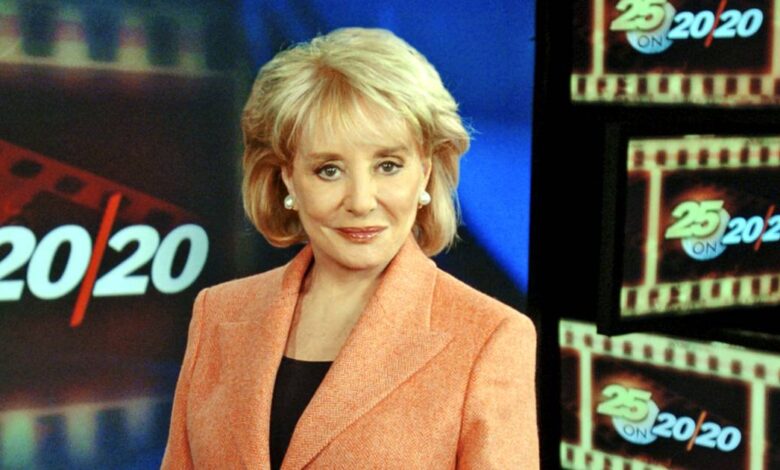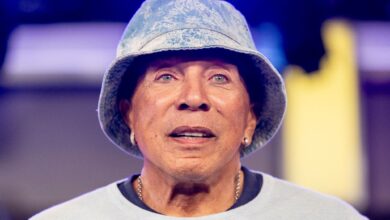Barbara Walters Doc Covers Family Estrangement, Controversial Exes

Barbara Walters’ personal life and career have been the subject of much fascination and intrigue over the years. A recent documentary, “Barbara Walters: Tell Me Everything,” delves into the iconic journalist’s life, shedding light on her groundbreaking career in journalism and the challenges she faced along the way.
Walters, known for her role as a trailblazer in the industry, paved the way for other women in journalism. From her early days as an anchor on the Today show to her time on ABC Evening News and 20/20, Walters made a significant impact on the field. She later cohosted The View for over two decades before retiring.
But beyond her professional accomplishments, the documentary also explores Walters’ personal life, including her tumultuous relationships and family dynamics. Walters, who passed away in December 2022 at the age of 93, had a complicated childhood marked by loneliness and family struggles.
One of the key revelations in the documentary is Walters’ difficult relationship with her sister, who was possibly autistic. Walters recalled a childhood incident where they were chased by boys, highlighting the challenges she faced growing up.
Walters also opened up about her parents, particularly her father, who was a gambler and eventually attempted suicide. This event had a profound impact on Walters, pushing her to support her family at a young age and shaping her future career path.
In terms of her love life, Walters had a delayed romantic period, as she focused on her career in her younger years. She became a mother through adoption with her second husband, Lee Guber, after suffering multiple miscarriages. Walters admitted that marriage was difficult for her, citing her parents’ troubled relationship as a factor.
Throughout her life, Walters was married and divorced three times, with her friends describing her as someone who was interested in romance but struggled with the institution of marriage. Walters herself reflected on her marriages, admitting that she often felt trapped and had a complicated relationship with the idea of marriage.
Despite her personal struggles, Walters’ legacy as a journalist and broadcaster remains unparalleled. She was known for her in-depth interviews with famous figures, from presidents to pop stars, and her dedication to her craft. The documentary sheds light on both the professional and personal sides of Walters, offering a nuanced look at the woman behind the iconic journalist.
As the documentary “Barbara Walters: Tell Me Everything” continues to garner attention and praise, it serves as a fitting tribute to a woman who made a lasting impact on the world of journalism and beyond.
Barbara Walters is a name synonymous with hard-hitting journalism and groundbreaking interviews. Throughout her six-decade career, Walters made a name for herself by fearlessly tackling controversial political leaders and interviewing some of the world’s most high-profile celebrities. However, behind the scenes, Walters’ personal life was just as intriguing as her professional endeavors.
One aspect of Walters’ life that often drew attention was her romantic relationships, particularly with individuals who were considered controversial figures. One such relationship that caused a stir was her romance with Roy Cohn, a notorious figure known for his involvement in political scandals. According to sources, Walters was both horrified and attracted to Cohn’s scoundrel-like behavior, which added a layer of complexity to their relationship.
Another acquaintance mentioned that Walters was a transactional person when it came to her relationships, often forming connections based on career moves rather than personal connections. Despite Cohn’s questionable actions, Walters credited him with helping her father out of debt, showing a willingness to overlook his flaws in favor of the assistance he provided to her family.
The documentary also shed light on Walters’ affair with Senator Edward Brooke, a relationship that had to be kept secret due to the societal norms of the time. Walters struggled with the decision to keep their relationship under wraps, ultimately feeling torn between her loyalty to Brooke and the potential consequences of their affair becoming public knowledge.
Walters’ personal life also faced challenges in her relationship with her daughter, who struggled with drug addiction as a teenager. The mother-daughter rift that ensued was a difficult period for Walters, who ultimately sent her daughter to an emotional growth school for three years to address her issues.
Additionally, the documentary explored Walters’ time at ABC News, where she faced discrimination as the only woman on staff. The lack of support and camaraderie from her colleagues, including co-anchor Harry Reasoner, created a hostile work environment for Walters. Despite her professional success, Walters admitted that this period was the most painful in her career.
Overall, Barbara Walters’ life was a tapestry of triumphs and challenges, both in her professional pursuits and personal relationships. Her ability to navigate the complexities of fame, romance, and motherhood showcased her resilience and determination in the face of adversity. Through it all, Walters remained a trailblazer in the field of journalism, leaving behind a legacy that continues to inspire and captivate audiences to this day. The world of technology is constantly evolving, with new innovations and advancements being made every day. From the latest smartphones to cutting-edge artificial intelligence, there is no shortage of new and exciting developments in the tech industry.
One of the most talked-about advancements in recent years is the rise of virtual reality (VR) technology. VR has the potential to completely revolutionize the way we interact with digital content, allowing users to immerse themselves in a completely virtual world. With the help of a VR headset and motion-tracking technology, users can move around and interact with objects in a virtual environment as if they were actually there.
But VR isn’t just for gaming and entertainment. It has the potential to be used in a wide range of industries, from healthcare to education to architecture. In the healthcare field, VR can be used to train medical students in realistic simulations, allowing them to practice procedures and surgeries in a safe and controlled environment. In education, VR can be used to take students on virtual field trips to far-off locations, giving them a hands-on learning experience that was never before possible.
In the world of architecture, VR can be used to create immersive 3D models of buildings and structures, allowing architects and designers to explore their creations in a virtual space before they are built. This can help identify potential design flaws and make adjustments before construction begins, ultimately saving time and money in the long run.
But VR isn’t the only exciting development in the tech world. Artificial intelligence (AI) is also making waves, with applications ranging from autonomous vehicles to personalized digital assistants. AI systems are becoming increasingly sophisticated, with the ability to learn and adapt to new situations in real-time.
One of the most well-known examples of AI in action is self-driving cars. Companies like Tesla and Google have been working on developing autonomous vehicles that can navigate roads and traffic patterns on their own. These vehicles use a combination of sensors, cameras, and AI algorithms to make decisions about when to accelerate, brake, and change lanes, ultimately making driving safer and more efficient.
AI is also being used in the healthcare industry to help diagnose and treat patients. Machine learning algorithms can analyze medical images and data to detect patterns and identify potential health issues, helping doctors make more accurate diagnoses and treatment plans.
As technology continues to advance at a rapid pace, the possibilities for innovation are endless. From VR to AI to the Internet of Things, the future of technology is sure to be filled with exciting new developments that will continue to shape the way we live, work, and play.





